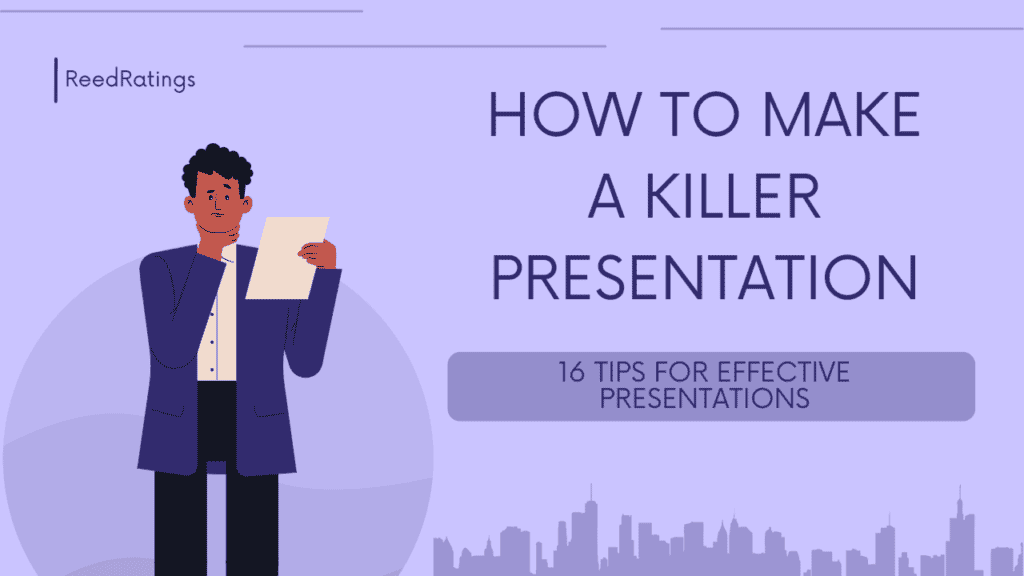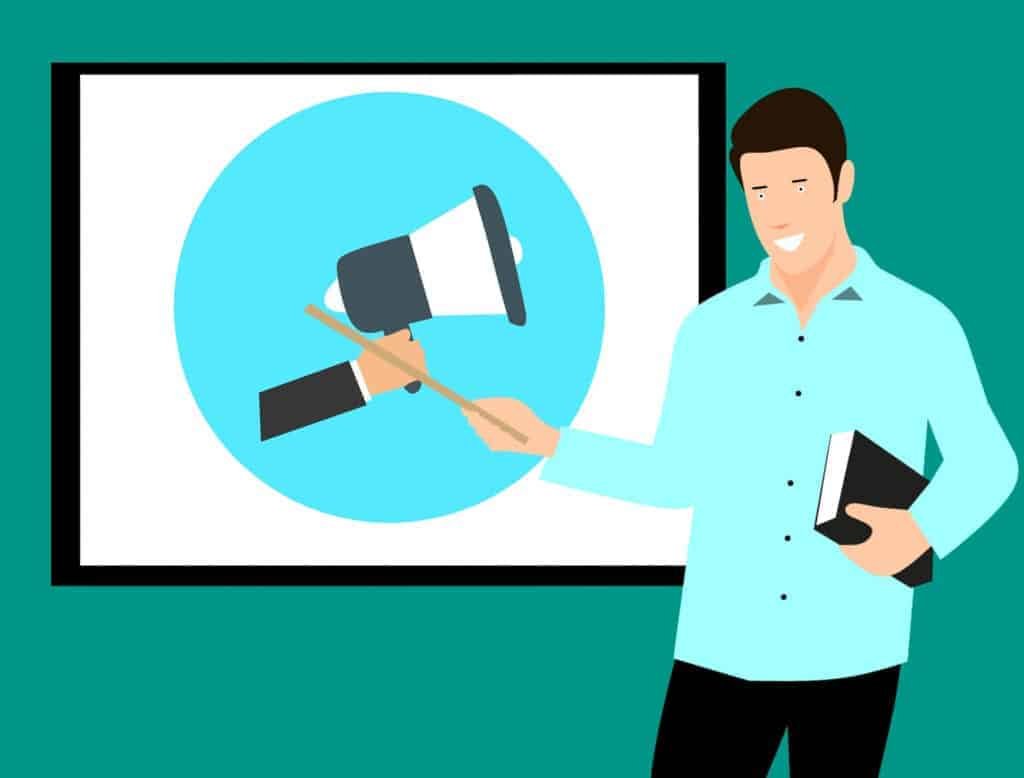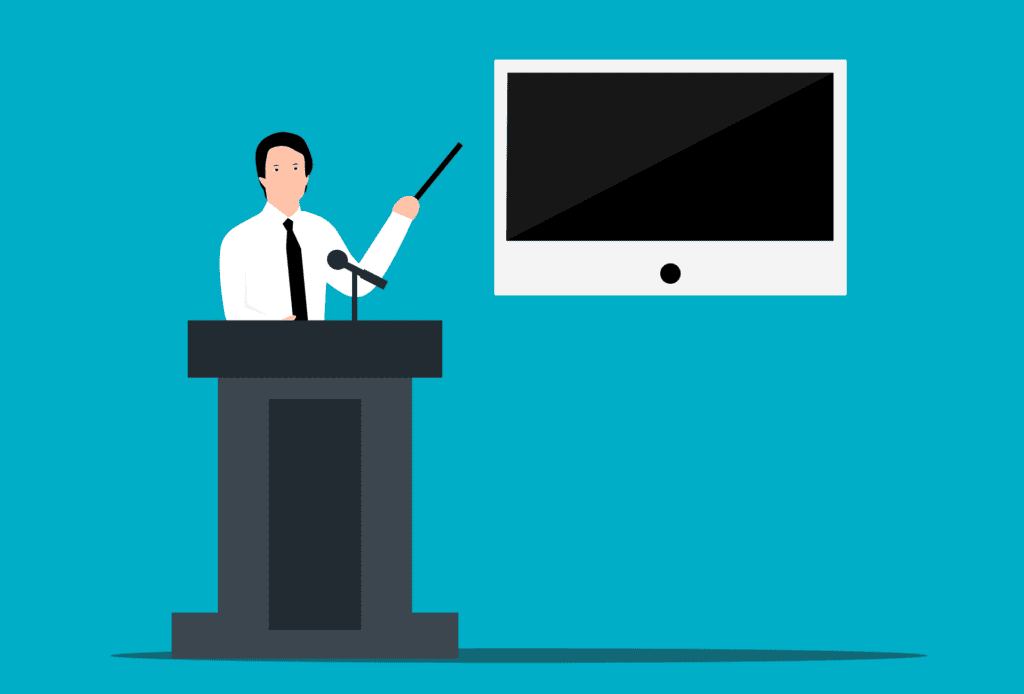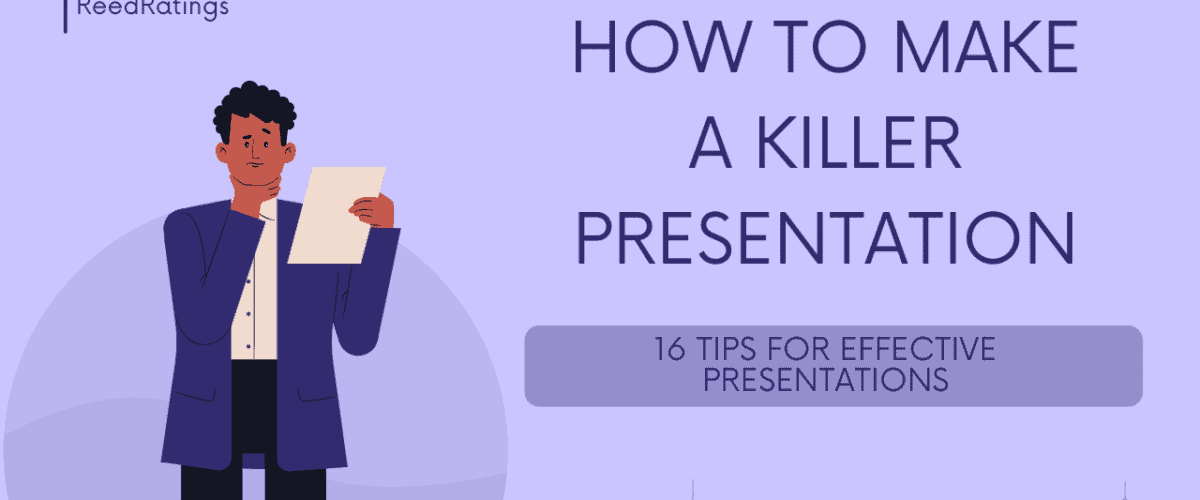So, you want to know how to make a presentation? Are you giving a presentation soon? Want to get ready? If so, make sure you follow these 16 tips to make a killer presentation!
Overview: First impressions are key when it comes to presentations, so make sure your slides look great and are easy to follow. You also want to make sure your content is interesting and engaging.
Keep your audience in mind when creating your presentation, and be prepared for questions at the end. By following these tips, you’ll be able to make a powerful impression on your audience and deliver an unforgettable presentation!
Now, let’s dive into how to make a presentation that will wow your audience!

How many types of presentations are?
There are several types of presentations, each with its own strengths and weaknesses. The most common type is the business presentation, which is typically used to communicate information about products, services, or company strategies.
Business presentations tend to be highly structured, with a clear introduction, body, and conclusion. However, they can also be dry and monotonous if not carefully planned.
Another common type of presentation is the academic presentation, which is often used to present research findings or share ideas with fellow scholars.
Academic presentations can be more intellectually stimulating than business presentations, but they also require a higher level of knowledge and understanding on the part of the audience.
There are personal presentations, which are often used to share stories or experiences with an audience. Personal presentations can be very powerful and moving, but they also require a high degree of trust between the presenter and the audience.
Ultimately, the best type of presentation depends on the goal of the presenter and the needs of the audience. And also this apply to online presentations.
Why make a presentation?
Giving a presentation is a great way to communicate your ideas to a large group of people. It can also be a great opportunity to make a strong impression on your audience.
Whether you’re presenting to potential clients or customers, or giving a talk at an industry conference, making a killer presentation is essential to success.
What are some common mistakes people make when giving presentations?
When giving a presentation, it is important to avoid making common mistakes that can undermine your credibility and negatively impact your audience’s perception of you. One mistake that is all too common is starting off on the wrong foot by appearing nervous or unprepared.
This can make you seem like you lack confidence in your material, which will in turn make your audience less likely to trust what you have to say. Another mistake to avoid is reading directly from your slides or notes.
This not only makes you come across as monotone and dull, but also prevents you from making eye contact with your audience, which makes it harder to engage them. Instead, try to memorize your material or paraphrase it so that you can look up at your audience while you speak.
Finally, be sure to practice your presentation beforehand so that you can deliver it confidently and smoothly on the day of.
How to make a presentation?

Making a presentation doesn’t have to be complicated. Just follow these simple tips and you’ll be on your way to giving a great presentation:
1. Use high-quality visuals
The use of high-quality visuals can make a big difference in the impact of a presentation. Good visuals can help to grab and hold attention, clarify ideas, and add interest and intrigue. In contrast, poor quality visuals can be distracting, confusing, and even offensive.
When selecting visuals for a presentation, it is important to choose images that are high resolution, well composed, and appropriate for the audience. Photographs, illustrations, infographics, and charts can all be effective visuals, as long as they are used judiciously.
A presentation with too many visuals can be overwhelming, so it is important to limit the number of visuals and choose those that will have the greatest impact. When used effectively, visuals can be a powerful tool for engage an audience and delivering a message.
2. Make sure your text is easy to read
When giving a presentation, it is important to make sure that your text is easy to read. There are several things you can do to ensure this. First, use a simple and clean font such as Arial or Times New Roman.
Avoid using ornate or decorative fonts, as they can be difficult to read from a distance. Second, use a light-colored background with dark text. This will help contrast the text and make it easier to read. Finally, use large font sizes, especially for headings and subheadings.
3. Choose an appropriate color scheme
When choosing a color scheme for a presentation, it is important to consider the purpose of the presentation and the audience. For example, if the presentation is for a group of businessmen, a more subdued color palette would be appropriate.
However, if the presentation is for a group of elementary school students, brighter colors would be more effective. Once the purpose and audience have been considered, the next step is to choose a color scheme that will complement the presentation material.
For example, if the presentation includes a lot of charts and graphs, a color scheme with high contrast would be more effective. Conversely, if the presentation includes mostly text, a softer color palette would be more appropriate.
4. Consider animation and transitions carefully
When planning a presentation, it is important to consider animation and transitions carefully. The wrong animations can seem juvenile or unprofessional, while too many transitions can be distracting.
However, used judiciously, animations and transitions can add interest and help to keep the audience engaged. For example, subtle animations can be used to highlight key points, or to call attention to a particular element of a slide.
Transitions can also be used effectively to introduce new topics or to emphasize the connection between different ideas. When used wisely, animation and transitions can be powerful tools for making an impactful presentation.
5. Keep it concise
You only have a limited amount of time for your presentation, so it is important to make sure that your message is clear and concise. This means avoiding distractions such as irrelevant stories or excessive detail.
Instead, focus on delivering the most essential information in an engaging way. Remember that your goal is to communicate your ideas clearly and effectively, so resist the temptation to add unnecessary fluff.
By being mindful of your time limit and staying focused on your key points, you can ensure that your presentation is both informative and impactful.
6. Engage your audience
When giving a presentation, it is important to engage your audience from the start. One way to do this is to begin with a question or a puzzle that will get them thinking. For example, you could ask them to guess the answer to a riddle or to solve a simple math problem.
Another way to engage your audience is to tell a story that is relevant to your topic. This could be a personal story or an anecdote about someone else. Whatever you choose, make sure it is interesting and captures the attention of your listeners.
Also, try to make eye contact with as many people as possible throughout your presentation. This will help to create a connection with your audience and ensure that they are paying attention.
7. Be prepared for questions
Any good presentation will include a time for questions from the audience. This is an important part of the presentation, as it allows the audience to interact with the presenter and deepen their understanding of the material.
However, many people find public speaking difficult, and the thought of being asked a question can be daunting. The best way to prepare for questions is to anticipate them in advance. Think about what topics might come up and how you would respond.
You can even write out your answers beforehand. Additionally, try to relax and be yourself during the presentation. If you seem confident and poised, audience members will be more likely to trust your expertise.
8. Be yourself and genuine
Being genuine in a presentation is one of the most important aspects of delivering a successful talk. When an audience member feels that you are being sincere, they are more likely to trust you and be engaged with what you are saying.
Furthermore, authenticity can help to build rapport and create a connection with your audience. This is especially important if you are trying to sell a product or service, as people are more likely to do business with someone they feel they can trust.
So, if you want your next presentation to be a success, make sure that you are being genuine. Remember, it’s not just about what you say, but how you say it. Body language and vocal cues can also play a role in conveying sincerity, so make sure to keep those in mind as well.
9. Practice, practice, practice!
When it comes to public speaking, there is no substitute for practice. The more you do it, the better you will become at crafting engaging and effective presentations. The key is to start small and gradually build up your confidence and skill.
Begin by giving speeches to friends or family members, then work your way up to delivering presentations to larger groups.
As you become more comfortable with speaking in front of an audience, you will be able to refine your delivery and better hone your message. With enough practice, you will eventually become a natural public speaker.
So if you want to improve your presentation skills, remember: practice makes perfect!
Delivery tips for making a killer presentation

Now that you know how to make a great presentation, it’s time to focus on delivery. Here are a few tips to make sure your presentation is killer:
10. Be confident
Giving a presentation can be nerve-wracking, whether you’re speaking to a small group or a large audience. But there are some things you can do to help boost your confidence and make sure your presentation goes off without a hitch.
First, it’s important to know your material inside and out. Before the big day, rehearse your presentation several times so you’ll be comfortable with the flow of the material.
It’s also helpful to have some notes on hand in case you get flustered during the presentation. Visual aids can also be helpful in keeping your audience engaged.
And finally, remember to breathe and relax-you’ve got this! By following these tips, you can give a confident and successful presentation.
11. Make eye contact
Making eye contact is an important part of presenting. It shows that you are confident and engaged with your audience. Plus, it helps to establish a connection with your listeners.
When you make eye contact, people are more likely to pay attention to what you’re saying and to remember what you’ve said. So, if you want to make sure that your presentation is effective, make sure to make eye contact with your audience!
12. Use gestures
When you’re giving a presentation, it’s important to use gestures to help you communicate your ideas effectively. Gestures can help emphasize key points, convey emotion, and add visual interest.
Used sparingly, they can also help to keep your audience engaged. Of course, it’s important to use gestures that are appropriate for the situation and audience.
For example, avoid using grandiose gestures if you’re speaking to a small group of people. And be aware of cultural differences – what might be considered polite in one culture could be seen as offensive in another.
With that in mind, here are some tips for using gestures effectively in your next presentation:
1. Use gestures to emphasize key points. A well-placed gesture can help to drive home an important point or highlight a key word or phrase. Just be sure not to overdo it – too many gestures can be distracting.
2. Use gestures to convey emotion. Adding a few hand gestures can help you show excitement, anger, or sadness – whatever emotions your presentation is trying to evoke. Again, beware of overdoing it – moderation is key.
3. Use gestures to add visual interest. Keeping your hands in constant motion can be distracting, but adding a few well-timed gestures can help to break up the monotony and add visual interest.
13. Speak clearly
When giving a presentation, it is important to speak clearly. This means enunciating your words and projecting your voice so that everyone in the room can hear you. You also want to avoid using filler words such as “um” or “like” which can make you sound unprepared or nervous.
Instead, take a deep breath and pause briefly before starting to speak. This will help you to slow down and choose your words carefully.
14. Use visual aids
Visual aids can be a helpful addition to any presentation. They can help to clarify complex ideas, emphasize important points, and add interest and variety. However, it is important to use visual aids effectively in order to avoid confusing or overwhelming your audience.
When choosing visual aids, be sure to select those that are clear, simple, and relevant to your topic. Avoid using too many visual aids or including irrelevant information. Remember that your goal is to support your presentation, not to provide a distraction.
15. End on a high note
As any experienced presenter knows, it’s important to end on a strong note. The last few minutes of your presentation are the ones that your audience is going to remember the most, so you want to make sure that you leave them with a positive impression.
There are a few different ways to do this. First, you can summarize the main points of your talk and restate your thesis. This will help to drive home the key points that you want your audience to remember.
Second, you can end with a powerful anecdote or story that illustrates the importance of your topic. This can be a great way to leave your audience with something to think about.
Finally, you can end with a strong call to action that encourages your audience to take action on the issue at hand.
Whichever approach you choose, ending on a high note will help to ensure that your presentation is remembered for all the right reasons.
16. Be conscious of your body language
The way you say something is often just as important as what you say. This is especially true when giving a presentation, when your words must compete for attention with your body language.
To ensure that your body is sending the right message, be conscious of your posture, gestures, and facial expressions. Stand up straight and make eye contact with your audience to convey confidence.
Use purposeful gestures to emphasize key points, but avoid fidgeting or wild gesticulations, which can be distracting. And finally, make sure that your facial expressions match the tone of your presentation.
A smile conveys warmth and enthusiasm, while a furrowed brow conveys concern or skepticism. By being aware of your body language, you can ensure that your message is communicated clearly and effectively.
After the presentation is over

After the presentation is over, make sure to thank the audience for their time. If there are any questions, answer them clearly and concisely. Finally, pack up your materials and leave the stage.
Once you’re off stage, take a deep breath and relax. Congratulate yourself on a job well done! If you have any feedback from the experience, reflect on it and make note of it for next time.
Presentations can be nerve-wracking, but with proper preparation and practice, they can be a breeze.
Presentation software to consider
When it comes to creating presentations, there are a variety of software options available. However, not all presentation software is created equal. Some programs are more user-friendly than others, and some offer more features and customization options.
For those who are looking for the best presentation software, it is important to consider all of the options before making a decision.
One of the best presentation software programs is Prezentar. Prezentar is known for its ease of use, and it offers a wide range of features and done for you templates that can be useful for creating presentations.
Now, no matter what type of presentation you need to create, there is a software program that can help you to do it. By taking the time to consider all of the available options, you can choose the best program for your needs.
Conclusion
Giving a presentation can be a daunting task, but with a little preparation and practice, you can make a killer presentation that will engage and impress your audience.
Just remember to focus on content, delivery, and multimedia use, and you’ll be giving great presentations in no time!
How to make a presentation FAQ’s
What are the best ways to make a presentation interesting and engaging?
When it comes to presentations, there is no one-size-fits-all solution. However, there are a few key strategies that can help to make any presentation more interesting and engaging.
First, it is important to focus on the audience’s needs. What will they be interested in learning about? What information do they need in order to make decisions? By tailoring the presentation to the audience’s needs, you will be able to hold their attention more effectively.
Second, try to use a mix of visual and verbal elements. People are generally more engaged when they are able to see as well as hear the information.
Third, avoid reading from a script or slides. This can be very boring for the audience. Instead, try to use bullet points as a guide and speak in a natural, conversational tone.
How do you keep your audience engaged during a presentation?
There are a few key things you can do to keep your audience engaged during a presentation. First, make sure to keep your eyes open and make contact with as many people in the room as possible.
This will help to create a connection with your audience and make them feel more invested in what you’re saying. Second, vary your vocal delivery – avoid monotony by speaking in different tones and volumes throughout your presentation.
Third, use gestures and expressions to emphasize your points – don’t just stand there like a statue! And finally, make sure to end on a strong note by summarizing your main points and leaving your audience with something to think about.
What are some tips for avoiding boredom during presentations?
Boredom is the enemy of all presenters, whether you’re giving a speech to a large audience or leading a meeting with your colleagues. The key to avoiding boredom is to keep your audience engaged, and there are a few ways to do this.
First, focus on telling a story rather than just reciting facts. Second, use props or visuals to break up the monotony of pure verbal communication. Finally, make sure to practice beforehand so that you feel confident and comfortable with your material.
Are there any tools or techniques that you find helpful when making presentations?
There are a few tools and techniques that I find helpful when making presentations. First, always make sure you have a clear and concise outline of your presentation.
This helps you to stay focused and on track while you are speaking. Second, make use of visual aids such as PowerPoint slides or handouts. This helps to engage the audience and keep their attention focused on the presentation.
One of the best tools that will help you create stunning presentations and slides is Prezentar.
Finally, practice you presentation several times before delivering it. This helps you to be more comfortable and confident when speaking in front of an audience.
Thanks for reading! Did you find this blog post helpful? Share it with your friends! It’s Darius, and I will catch you up in my next article. Stay safe!

